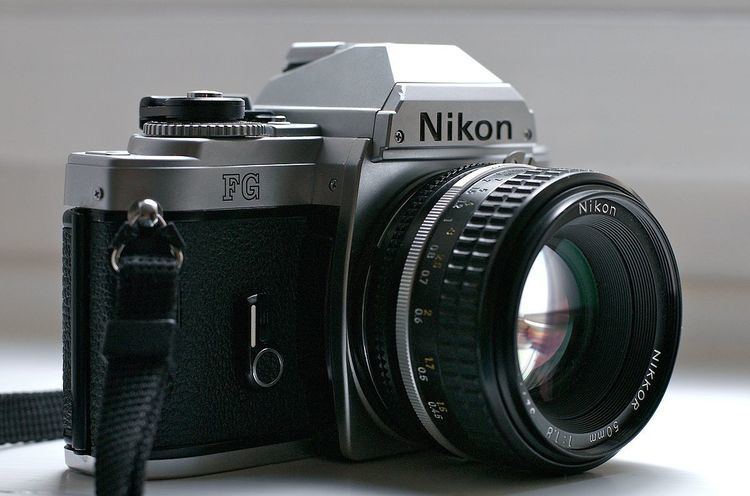Type Single lens reflex Film size 36mm x 24mm | Film format 35mm Film advance manual | |
 | ||
Compatible lenses Nikon F-mount lenses supporting automatic indexing (AI) with some exceptions | ||
The Nikon FG is an interchangeable lens, 35 mm film, single-lens reflex (SLR) camera. It was manufactured by Nippon Kogaku K. K. (Nikon Corporation since 1988) in Japan from 1982 to 1986.
Contents
- Features
- Body Construction
- Exposure Control and Metering
- Viewfinder
- Flash Exposure Control
- Lens Compatibility
- MF 15 databack
- Nikon Speedlights
- Background and Design History
- Market Reception
- Compared to Nikon EM and FG 20
- References
The FG was the successor to the Nikon EM camera of 1979 and the predecessor of the Nikon FG-20 of 1984. These three cameras comprised Nikon's first family of ultra compact 35mm SLR camera bodies. Although the FG had a much less advanced shutter than the more expensive Nikons of the day, it had a very sophisticated electronic design compared to earlier electromechanical Nikons.
Features
Body Construction
Exposure Control and Metering
The FG's metering system is controlled by a micro-computer which measures center-weighted brightness, using a sensitive silicon photodiode (SPD) sensor. The metering system performs 'instant stop down metering', where the meter reading is taken after the lens is stopped down but before the mirror flips up and the shutter opens.
In 'P' (Programmed AE) mode, the micro-computer calculates stepless aperture (f/stop) and stepless shutter speed using pre-programmed values.
In 'A' (Aperture Priority AE) mode, the micro-computer calculates a stepless shutter speed for a given user-selected aperture value.
In 'M' (Manual Exposure Control) mode, the user selects both aperture and shutter speed, and the metering system provides a suggested shutter speed (indicated in the viewfinder) for the selected aperture.
Viewfinder
The focusing screen is a standard Nikon 'K-type' screen with:
Displayed on the right side of the viewfinder are:
Flash Exposure Control
The FG was also Nippon Kogaku’s first amateur level SLR to have through-the-lens TTL off-the-film (OTF) electronic flash automation. However this technology was first introduced with the Olympus OM-2 in 1976. and was also used previously in the Nikon F3 introduced in 1980. TTL OTF flash exposure control is more precise than previous methods as it measures the flash exposure at the film plane rather than at the flash itself. Correct flash exposure is achieved via a SPD cell at the base of the mirror box, which measures light reflected back from the film plane.
The FG can only connect to flashes via the hot shoe connection, as it lacks a PC sync socket. Flashes which do not have a hot shoe can be used with a hot shoe-sync cord adapter.
Lens Compatibility
MF-15 databack
Nikon Speedlights
The FG can be used with any dedicated Nikon speedlights (flashes) which support TTL flash exposure, and any non-dedicated flash units in either automatic or manual modes.
Dedicated, hot shoe mounted Nikon speedlights available during the time the FG was manufactured were the SB-E, SB-15, SB-16B, SB-18 and SB-19.
Background and Design History
The 1970s and 1980s were an era of intense competition between the major SLR brands: Nikon, Canon, Minolta, Pentax and Olympus. This was in part a result of rapid advances in electronics at the time, which allowed new cameras to be released more frequently and with more automated features than had been possible previously.
Between c. 1975 to 1985, there was a dramatic shift away from heavy all-metal manual mechanical camera bodies to much more compact bodies with integrated circuit (IC) electronic automation. As a result of the manufacturing climate of the time, the EM and subsequent FG and FG-20 were released with much lower price points, and more compact and user-friendly bodies than previous Nikons, to appeal to the amateur photographer market.
The FG was intended to improve on the short-comings of the EM (which had no manual override) and to compete with other programmed SLRs of the time, such as the Canon AE-1 Program (released 1981) the Minolta X-700 (released 1981) or the Pentax Super Program (in the USA/Canada; Super A, rest of the world; 1983).
Market Reception
The FG was well received by many amateur photographers, but was criticised by others due to the lower build-quality and reliability when compared to other Nikons of the same era. The FG has known reliability issues, particularly with its shutter components and ICs.
Compared to Nikon EM and FG-20
The major improvements of the FG compared to the EM were improved exterior cosmetics, internal printed circuit electronics, the addition of the manual exposure and programmed autoexposure modes, and provision for TTL flash automation.
The FG-20 is a simplified version of the Nikon FG, with no Programmed AE mode, no TTL OTF flash, and no exposure control, but retaining Aperture Priority AE, and manual and auto flash exposure control.
